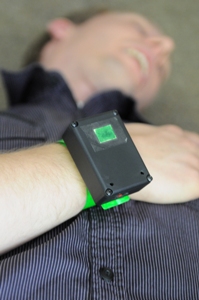Dec 3 2013
When large-scale emergencies occur, it often takes far too long before victims receive the care their injuries demand. Now a new electronic system has been designed to support helpers during the initial assessment of victims and to speed up patient care.
 The armband color coding indicates the severity of injury. First responders can decide immediately whether the victim should be taken to a hospital or can be treated on site. © Fraunhofer FIT
The armband color coding indicates the severity of injury. First responders can decide immediately whether the victim should be taken to a hospital or can be treated on site. © Fraunhofer FIT
When a major catastrophic event occurs, every second counts. During instances such as natural disasters, terrorist attacks, accidents in chemical plants, or train crashes, many human lives depend on how well the rescue services are coordinated. The better relief forces communicate with each other, the more victims they can rescue. The swifter the initial assessment of those affected by the disaster (during which they are tagged according to the severity of their in- juries), the faster they can be evacuated and taken to suit- able nearby hospitals. At present, this initial assessment – or “triage” as the professionals call it – is carried out using colored paper tags which first responders attach to victims. The color coding (green, yellow, red, and black) indicates the severity of the injury and the treatment priority. Pulse and respiratory rate are noted on the tags by hand. This col- lected data summarizes the condition of the victim at the time of triage, but the manual process means frequent up- dates are seldom possible. Another drawback is that the paper tags are easily damaged during poor weather conditions.
Better first response medical care, optimized emergency management, and the more ef- fective operation of rescue forces in response to large-scale accidents are the goals that the EU’s BRIDGE project is trying to promote (www.bridgeproject.eu). The EU is funding the project to the tune of 13 million euros, and the Fraunhofer Institute for Applied Information Technology FIT in the German city of Sankt Augustin is responsible for its overall technical coordination. With eTriage, FIT researchers are developing a system to replace the paper tags. The system will locate casualties and transmit their vital signs such as pulse, res- piratory rate, and blood oxygen to emergency response control centers in real time.
Emergency management with GPS and RFID
eTriage consists of several elements. Instead of using paper tags, first responders put color-coded armbands made of light, bendy plastic on casualties. These triage armbands are the cornerstone of the system and comprise a GPS sensor, an RFID chip, and a net- work component for communication with the data network. Unharmed people receive only an armband with GPS sensor, whereas unstable and severely injured victims have sensors attached to their bodies that transmit vital signs to the emergency response control center. The armband functions as an interface and network node. The data can be transmitted via a ZigBee – a slow but far-ranging and economical radio network – but also via WLAN or the cellular network.
“This is a big advantage, because communication is often the first thing that breaks down during a catastrophe. We use the other networks when they’re available, but when they’re not, we simply build our independent, fully functioning ZigBee network. The required infra- structure is already there in the armbands. It works automatically – there’s no extra work involved,” explains Erion Elmasllari, a scientist at FIT. Triage relays attached to first res- ponders’ belts additionally function as caches, data backup and data transmitters should the ZigBee network ever collapse.
Data transmitted by triage armbands is displayed on a tablet PC or smartphone. A map view and an augmented reality view give first responders and response coordinators a quick overview of the situation on the ground. By clicking on icons whose colors match those of the armbands, they receive all the information available about the location of vic- tims, their state of health, degree of injury, and physical signs. Rescuers see at a glance where the majority of severely injured casualties are located. They can decide immediately which hospitals victims should be taken to, whether on-site care is sufficient or whether heli- copters should be requested. “With our eTriage system, a severely injured person categorized as red is reported within no more than 30 seconds and can be evacuated immediately. With the conventional paper tag method, it often takes up to 30 minutes before the victim is evacuated,” says Elmasllari.
Researchers were able to test the system’s reliability in a live situation during a five-hour major disaster exercise – a simulated terrorist attack on a ferry terminal – that took place this October in Stavanger in Norway. Throughout the large-scale operation with 350 victims, 50 first responders, 30 ambulances, several helicopters, and a mobile response control center, the interplay of triage components worked perfectly. The next milestone is a two- month test within a relief organization, with researchers looking to demonstrate how eTriage can speed up patient care, improve logistical processes, and optimize rescue procedures.